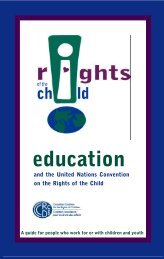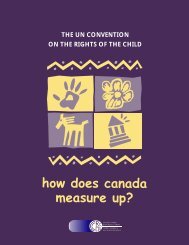CCRC report on rights of children in Canada - Canadian Coalition ...
CCRC report on rights of children in Canada - Canadian Coalition ...
CCRC report on rights of children in Canada - Canadian Coalition ...
Create successful ePaper yourself
Turn your PDF publications into a flip-book with our unique Google optimized e-Paper software.
“We would like you [the UN Committee <strong>on</strong> the Rights <strong>of</strong> the Child] to ask the Government <strong>of</strong> <strong>Canada</strong><br />
why there are no schools <strong>in</strong> many <strong>of</strong> our communities and why so many <strong>of</strong> our schools are <strong>in</strong> such poor<br />
c<strong>on</strong>diti<strong>on</strong>. We want to know why the level <strong>of</strong> fund<strong>in</strong>g we receive for educati<strong>on</strong> is less compared to<br />
communities <strong>in</strong> other parts <strong>of</strong> Ontario and <strong>Canada</strong>. We also want to know why we have to fight so hard<br />
for what our peers <strong>in</strong> other parts <strong>of</strong> <strong>Canada</strong> are able to take for granted.”<br />
Youth Dream Team (River Tenasco, Daisey Brascoupe, Shawnesia Ottawa, Chelsea Edwards, Shauna Jerome) 1<br />
“… Well the three or four th<strong>in</strong>gs I would like people to know about me is. One, I do not like broken<br />
promises. Two, I do not like see<strong>in</strong>g my sibl<strong>in</strong>gs go<strong>in</strong>g to school <strong>in</strong> washrooms. And three, I would like them<br />
to know too that I AM NOT GIVING UP.” 2<br />
Shannen Koostach<strong>in</strong>, 14 years old, 2008<br />
“Mov<strong>in</strong>g from home to home, I always had to change schools, and that prevented me from gett<strong>in</strong>g<br />
comfortable with the teachers or the school. It’s important for <strong>children</strong> and youth to be stable <strong>in</strong> <strong>on</strong>e<br />
place and <strong>in</strong> what they’re do<strong>in</strong>g.”<br />
“We lost a lot <strong>of</strong> students because they couldn’t handle the change from reserve to city. The transiti<strong>on</strong> is<br />
sometimes too much for students to take and it affects their educati<strong>on</strong>.” 3<br />
Youth C<strong>on</strong>sultati<strong>on</strong>, 2009<br />
“I would like to see native aborig<strong>in</strong>al students treated and funded the same as any other n<strong>on</strong>-aborig<strong>in</strong>al<br />
students because we are all students, we are all human, we are all equal and should be treated as such.” 4<br />
Wesley<br />
Young people said, “Clean water should be provided <strong>on</strong> reserves.” They ask for better school<strong>in</strong>g <strong>on</strong><br />
reserves, more funds for community centers and hous<strong>in</strong>g, funds for mental health and drug abuse<br />
therapy, and to raise more awareness about those issues throughout <strong>Canada</strong> to all <strong>Canadian</strong>s <strong>in</strong> schools.<br />
Youth recommend “history classes help<strong>in</strong>g us understand what happened to Natives and where racism<br />
has stemmed from, and how they live now, not just <strong>in</strong> the past.”<br />
<str<strong>on</strong>g>CCRC</str<strong>on</strong>g> Youth C<strong>on</strong>sultati<strong>on</strong>, September 2011<br />
“We d<strong>on</strong>’t know much about Aborig<strong>in</strong>al issues even though we’re still <strong>in</strong> school and we d<strong>on</strong>’t know many<br />
Aborig<strong>in</strong>al people. It’s like they are always separated from us. Sometimes it seems like a good idea to<br />
<strong>in</strong>tegrate them <strong>in</strong>to our schools but then they are away from home and probably gett<strong>in</strong>g bullied.”<br />
<str<strong>on</strong>g>CCRC</str<strong>on</strong>g> Youth C<strong>on</strong>sultati<strong>on</strong>, August 24th, 2011<br />
“Aborig<strong>in</strong>al <strong>children</strong> are experienc<strong>in</strong>g high rates <strong>of</strong> abuse and sex exploitati<strong>on</strong>. Their parents and<br />
grandparents came out <strong>of</strong> residential schools where they experienced those th<strong>in</strong>gs and they’re pass<strong>in</strong>g<br />
them <strong>on</strong>. Need to help Aborig<strong>in</strong>al parents as well without try<strong>in</strong>g to impose belief and values.”<br />
<str<strong>on</strong>g>CCRC</str<strong>on</strong>g> Youth C<strong>on</strong>sultati<strong>on</strong>, August 24th, 2011<br />
1 Dream Team, “Letter to the UNCRC”, <strong>in</strong> Our Dreams Matter Too: First Nati<strong>on</strong>s <strong>children</strong>’s <strong>rights</strong>, lives and educati<strong>on</strong>: An alternate <str<strong>on</strong>g>report</str<strong>on</strong>g> from the Shannen’s Dream Campaign to the United<br />
Nati<strong>on</strong>s Committee <strong>on</strong> the Rights <strong>of</strong> the Child <strong>on</strong> the occasi<strong>on</strong> <strong>of</strong> <strong>Canada</strong>’s 3rd and 4th periodic reviews, Tor<strong>on</strong>to, The Office for the Prov<strong>in</strong>cial Advocate for Children and Youth, 2011, p. 11,<br />
available at http://www.fncfcs.com/shannensdream/our-dreams-matter-too, accessed October 9, 2011.<br />
2 Shannen Koostach<strong>in</strong>, Letter dated July 27, 2008, available at<br />
www.fncfcs.com/sites/default/files/shannensdream/Shannens-letter.pdf accessed October 10, 2011.<br />
3 Land<strong>on</strong> Pears<strong>on</strong> Resource Centre for the Study <strong>of</strong> Childhood and Children’s Rights, Shak<strong>in</strong>g the Movers III Child Rights <strong>in</strong> Educati<strong>on</strong> CRC Articles 28, 29, and 42, F<strong>in</strong>al Report, Ottawa,<br />
Land<strong>on</strong> Pears<strong>on</strong> Resource Centre, June 2009, p. 9.<br />
4 Wesley, <strong>in</strong> Our Dreams Matter Too: First Nati<strong>on</strong>s <strong>children</strong>’s <strong>rights</strong>, lives and educati<strong>on</strong>, An alternate <str<strong>on</strong>g>report</str<strong>on</strong>g> from the Shannen’s Dream Campaign to the United Nati<strong>on</strong>s Committee <strong>on</strong> the<br />
Rights <strong>of</strong> the Child <strong>on</strong> the occasi<strong>on</strong> <strong>of</strong> <strong>Canada</strong>’s 3rd and 4th periodic reviews, Tor<strong>on</strong>to, The Office for the Prov<strong>in</strong>cial Advocate for Children and Youth, 2011, p. 26, available at http://www.<br />
fncfcs.com/shannensdream/our-dreams-matter-too, accessed October 9, 2011.<br />
b PROTECTING THE RIGHTS OF<br />
CHILDREN IN GOVERNMENT AND<br />
ALTERNATIVE CARE<br />
Introducti<strong>on</strong><br />
There were an estimated 67,000 <strong>children</strong> <strong>in</strong> out-<strong>of</strong>-home care across <strong>Canada</strong> <strong>in</strong> 2007. The most<br />
comm<strong>on</strong> reas<strong>on</strong> for plac<strong>in</strong>g <strong>children</strong> <strong>in</strong> substitute or alternative care is abuse or neglect. Other reas<strong>on</strong>s<br />
<strong>in</strong>clude death <strong>of</strong> parents, parental mental illness, drug and alcohol abuse, poverty, and family violence. 62<br />
There are few nati<strong>on</strong>al sources <strong>of</strong> <strong>in</strong>formati<strong>on</strong> or analysis <strong>of</strong> the situati<strong>on</strong> <strong>of</strong> <strong>children</strong> need<strong>in</strong>g special<br />
protecti<strong>on</strong>. The rate <strong>of</strong> child abuse <strong>in</strong>vestigati<strong>on</strong>s <strong>in</strong> 2008 (39.16 per 1,000 <strong>children</strong>) was similar to what<br />
it was <strong>in</strong> 2003 (38.33 per 1,000 <strong>children</strong>), accord<strong>in</strong>g to a nati<strong>on</strong>al database <strong>on</strong> child abuse. 63 These are<br />
<strong>on</strong>ly <strong>of</strong>ficially <str<strong>on</strong>g>report</str<strong>on</strong>g>ed cases. Research highlights that child neglect and abuse are under-<str<strong>on</strong>g>report</str<strong>on</strong>g>ed <strong>in</strong> all<br />
parts <strong>of</strong> <strong>Canada</strong>.<br />
<strong>Canada</strong>’s ten prov<strong>in</strong>ces and three territorial jurisdicti<strong>on</strong>s each have their own child welfare legislati<strong>on</strong><br />
and their own systems for protect<strong>in</strong>g <strong>children</strong> and deliver<strong>in</strong>g services. Comm<strong>on</strong> elements <strong>in</strong> all<br />
jurisdicti<strong>on</strong>s <strong>in</strong>clude the follow<strong>in</strong>g:<br />
• A def<strong>in</strong>iti<strong>on</strong> <strong>of</strong> “a child <strong>in</strong> need <strong>of</strong> protecti<strong>on</strong>” establishes the grounds for <strong>in</strong>terventi<strong>on</strong> by a<br />
government department or a child protecti<strong>on</strong> agency;<br />
• A child’s family is legally recognized as the primary caregiver; remov<strong>in</strong>g a child from a family is<br />
c<strong>on</strong>sidered a “last resort”;<br />
• The ‘best <strong>in</strong>terests <strong>of</strong> the child’ pr<strong>in</strong>ciple is legally recognized, but a best <strong>in</strong>terest determ<strong>in</strong>ati<strong>on</strong><br />
is generally d<strong>on</strong>e <strong>on</strong>ly <strong>in</strong> a court proceed<strong>in</strong>g after a child has been found <strong>in</strong> need <strong>of</strong> protecti<strong>on</strong><br />
because a m<strong>in</strong>imum standard <strong>of</strong> parental care has not been met;<br />
• When a child is removed from the care <strong>of</strong> parents, there is a duty to explore alternative care (i.e.<br />
k<strong>in</strong>ship care, placement with extended family or a community member) before plac<strong>in</strong>g the child <strong>in</strong><br />
substitute care (i.e. <strong>in</strong> a foster home, group home, or residential facility); and<br />
• A disproporti<strong>on</strong>ate percentage <strong>of</strong> Aborig<strong>in</strong>al <strong>children</strong> are <strong>in</strong> the child welfare system, with a<br />
significantly higher percentage <strong>in</strong> Western <strong>Canada</strong>.<br />
There are significant differences <strong>in</strong> the def<strong>in</strong>iti<strong>on</strong>s <strong>of</strong> a child <strong>in</strong> need <strong>of</strong> protecti<strong>on</strong>, the age limits for<br />
child protecti<strong>on</strong>, implementati<strong>on</strong> <strong>of</strong> child welfare legislati<strong>on</strong>, and the services provided to <strong>children</strong>. The<br />
need for significant changes <strong>in</strong> child welfare to meet C<strong>on</strong>venti<strong>on</strong> obligati<strong>on</strong>s has been identified at all<br />
levels, from pr<strong>of</strong>essi<strong>on</strong>al practiti<strong>on</strong>ers to young people <strong>in</strong> care.<br />
In 2009 a nati<strong>on</strong>al, multi-discipl<strong>in</strong>ary c<strong>on</strong>ference <strong>on</strong> the Best Interest <strong>of</strong> the Child: Mean<strong>in</strong>g and<br />
Applicati<strong>on</strong> <strong>in</strong> <strong>Canada</strong> brought together practiti<strong>on</strong>ers, policy-makers, and advocates. A workshop <strong>on</strong><br />
There currently are no <strong>Canada</strong>-wide statistics <strong>on</strong> the number <strong>of</strong> <strong>children</strong> and youth placed by child welfare authorities <strong>in</strong> out-<strong>of</strong>-home care. Child welfare services fall under the jurisdicti<strong>on</strong> <strong>of</strong><br />
prov<strong>in</strong>cial and territorial authorities, mak<strong>in</strong>g it difficult to compile statistics at a nati<strong>on</strong>al level. The most current estimate is provided by: Mulcahy, M & N. Trocmé, “CECW Informati<strong>on</strong> Sheet<br />
#78E: Children and Youth <strong>in</strong> Out-<strong>of</strong>-Home Care <strong>in</strong> <strong>Canada</strong>”. M<strong>on</strong>treal, QC, Centre for Research <strong>on</strong> Children and Families, McGill University, 2010, available at www.cecw-cepb.ca/sites/default/<br />
files/publicati<strong>on</strong>s/en/ChildrenInCare78E.pdf accessed October 25, 2011..<br />
64 Right <strong>in</strong> pr<strong>in</strong>ciple, right <strong>in</strong> practice Pay<strong>in</strong>g Attenti<strong>on</strong> to Vulnerable Children 65




